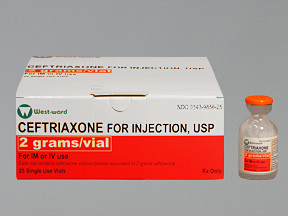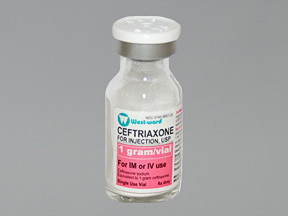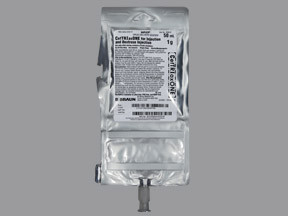CEFTRIAXONE - INJECTION
PHONETIC PRONUNCIATION: (SEF-trye-AX-one)
COMMON BRAND NAME(S): Rocephin
GENERIC NAME(S): ceftriaxone sodium
Uses
USES: Ceftriaxone is used to treat a wide variety of bacterial infections. This medication belongs to a class of drugs known as cephalosporin antibiotics. It works by stopping the growth of bacteria. This drug is not recommended for use in newborns with high blood bilirubin levels and premature infants due to increased risk of side effects. Ask the doctor or pharmacist for details.
How to use CEFTRIAXONE - INJECTION
HOW TO USE: This medication is given by injection into a muscle or vein as directed by your doctor, usually once or twice daily. The dosage is based on your medical condition and response to treatment. Drink plenty of fluids while using this medication unless your doctor directs you otherwise. If you are using this medication at home, learn all preparation and usage instructions from your health care professional. Avoid mixing ceftriaxone with IV fluids that have calcium in them (such as Ringer's solution, Hartmann's solution, parenteral nutrition-TPN/PPN). Consult your pharmacist for details about the safe use of IV calcium products in infants, children, and adults (see Precautions section). Before using, check this product visually for particles or discoloration. If either is present, do not use the liquid. Learn how to store and discard medical supplies safely. If you are using the frozen pre-mixed solution, thaw the bag at room temperature or in the refrigerator. If the bag is thawed in the refrigerator, let it sit at room temperature at least 1 hour before using. Do not thaw by putting in a water bath or microwaving. After thawing, shake well and squeeze the bag to check for leaks. Discard solution if the bag leaks. Do not re-freeze the solution after thawing. For the best effect, use this antibiotic at evenly spaced times. To help you remember, use this medication at the same time(s) every day. Continue to use this medication for the full time prescribed, even if symptoms disappear after a few days. Stopping the medication too early may result in a return of the infection. Tell your doctor if your condition lasts or gets worse.
Side Effects
Precautions
Interactions
Overdose
Images
Reviews
Faq for CEFTRIAXONE - INJECTION
Ceftriaxone is an antibiotic medication used to treat various types of bacterial infections such as respiratory tract infections, skin infections, urinary tract infections, meningitis, and gonorrhea.
Ceftriaxone is administered as an injection, either through a vein (intravenous) or into a muscle (intramuscular).
Common side effects include diarrhea, nausea, vomiting, stomach pain, headache, and rash. Serious side effects may include allergic reactions, severe diarrhea, or changes in liver function.
The onset of action for Ceftriaxone is usually within a few hours to a few days, depending on the type and severity of the infection being treated.
Ceftriaxone is generally considered safe to use during pregnancy and while breastfeeding, but it is important to consult with a healthcare provider before using any medication during these periods.
It is generally recommended to avoid alcohol while taking Ceftriaxone, as it may increase the risk of certain side effects such as nausea, vomiting, and headache.
Ceftriaxone should be stored in a refrigerator, away from light and moisture. It should not be frozen.
If you miss a scheduled dose, contact your healthcare provider for instructions. It is important to take the medication as prescribed to ensure effectiveness.
Ceftriaxone may interact with certain medications, including blood thinners and medications that affect kidney function. Inform your healthcare provider about all the medications you are taking to avoid potential interactions.
Disclaimer
IMPORTANT: HOW TO USE THIS INFORMATION: This is a summary and does NOT have all possible information about this product. This information does not assure that this product is safe, effective, or appropriate for you. This information is not individual medical advice and does not substitute for the advice of your health care professional. Always ask your health care professional for complete information about this product and your specific health needs.






No Reviews Yet